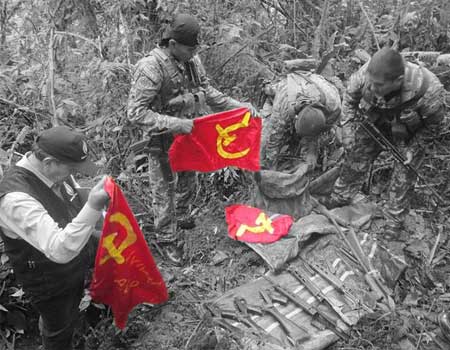The Shining Path or the Militarized Communist Party of Peru (Militarizado Partido Comunista de Peru – MPCP) is the last remnant of Peru’s guerrilla movement from the end of the 20th Century. Although the group is declining, it still maintains influence in the Apurímac, Ene, and Mantaro Rivers Valley (Valle de los Ríos Apurímac, Ene y Mantaro – VRAEM) due to its drug trafficking alliances.
The guerrilla group’s main sources of income are providing protection services for drug shipments and escorting drug traffickers. The government describes the VRAEM group as nothing more than a drug trafficking gang, but the situation is more complicated, and the group continues to carry out propaganda activities and attacks against security forces in addition to providing protection services to drug traffickers.
In recent years, the group has resumed violent actions against farmers and security forces, demonstrating its resilience in the face of ongoing operations to dismantle it.
History
The Communist Party of Peru – Shining Path, was formed in 1970 as a breakaway faction from the Peruvian Communist Party (Partido Comunista Peruano – PCP). It had only a few dozen members, led by Abimael Guzmán, a philosophy professor at the University of Ayacucho who had visited China and was deeply influenced by the ideas of Mao Zedong. Guzman believed communism required the waging of a “popular war” and criticized members of the PCP who merely wanted to participate in political institutions and electoral processes.
By 1980 his group had grown to more than 500 members, and was ready to declare war on the Peruvian state. The group carried out attacks, particularly on police stations, and in December 1982, the army was sent to fight them.
The Shining Path massacred peasant communities it considered to be against its struggle, and attacked security forces and other representatives of the state. It gained ground rapidly and was present in large parts of the country in the late 1980s.
Though the Shining Path remained small, with around 3,000 members at the peak of its power in 1990, it was responsible for the majority of the victims of the war that followed. A truth and reconciliation commission found that it killed some 31,800 people between 1980 and 2000. The group’s methods were particularly brutal, including stoning victims to death, among other war crimes.
The tide of the war began to turn when President Alberto Fujimori took office in 1990, and launched an assault on the rebels, which included locking up and torturing suspected sympathizers, as well as arming Peasant Patrols (Rondas Campesinas), which were rural self-defense forces who fought the guerrillas.
Guzmán was captured in Lima in 1992, and later called on his followers to make a peace deal with the government. This precipitated a break in the group, with rebels based in the VRAEM region declaring Guzmán to be a traitor, while another group, based further north in the Huallaga Valley, remained loyal.
The Shining Path’s activity died down significantly until the mid-2000s, when there was a resurgence, including attacks on multinational corporations, particularly from the VRAEM branch.
The Huallaga faction is thought to have been dismantled after the capture of its leader, Florindo Eleuterio Flores Hala, alias “Comrade Artemio,” in 2012. He was the last leader in the field who remained loyal to Guzmán. Now there is no link between the rebels still in the field and the high commanders in prison.
While the remnants of the Shining Path continue to espouse a Maoist ideology and to launch attacks on security forces, since 1992 they prefer to identify themselves as the Militarized Communist Party of Peru (Militarizado Partido Comunista del Perú – MPCP) in order to distance themselves from the history of the guerrilla and receive greater support from the rural farming communities.
Leadership
The founder of the guerrilla group, Abimael Guzmán, alias “Gonzalo,” was captured in 1992, causing a division with the group. The Huallaga faction, led by Florindo Eleuterio Flores, alias “Comandante Artemio,” now in prison, remained loyal to Guzmán and dissolved after the arrest of Flores. The other faction in the VRAEM is led by Victor Quispe Palomino, alias “Camarada José,” whose second-in-command was his brother Jorge, also known as “Raúl,” until his death in 2021.
Geography
Currently, the remnants of the Shining Path find themselves in a narrow but strategic drug trafficking corridor between the departments of Junín, Ayacucho, and Huancavelica in the VRAEM, the country’s main drug producing region. The base of the Quispe Palomino brothers is in Vizcatán, in the heart of the jungle of the VRAEM, a strategic location for controlling key drug trafficking routes towards Brazil and Bolivia. Additionally, the group controls the port of El Callao, where nearly 40% of the drugs produced in the VRAEM are trafficked.
Allies and Enemies
At the beginning of the first decade of the 2000s, the Shining Path established links with the Revolutionary Armed Forces of Colombia (Fuerzas Armadas Revolucionarias de Colombia – FARC) guerrilla group, from whom they learned some war tactics, like the use of rocket launchers to shoot down military airplanes. Currently, the Shining Path has alliances and businesses with local drug trafficking clans from the VRAEM.
Prospects
Despite losing one of their key leaders and the overall weakening of the organization, the Shining Path’s alliances with drug traffickers, control of strategic territories in the VRAEM and the resilience to years of military operations show that putting an end to this organization will not be an easy task for state security forces.
Recent operations against the newest generation of the group could weaken it, but they do not guarantee the end of criminal structures in the VRAEM, where coca cultivation and other illicit economies persist. The group’s adaptability suggests that, even without their leaders, its transformation towards organized crime is likely to continue.

